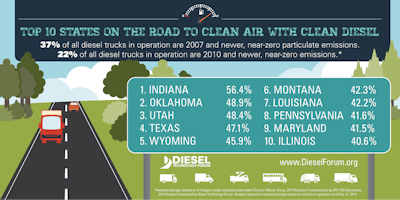More than 40 percent of all medium and heavy-duty diesel commercial trucks in the U.S. are now equipped with newer technology clean diesel engines, according to a recent Diesel Technology Forum (DTF) analysis.
DTF reported examining operation statistics from IHS Automotive vehicles and found that 4 million of 9.5 million Class 3 – 8 diesel trucks in the U.S. are operating at near zero emissions levels.
“The U.S. trucking fleet is transitioning to newer clean diesel technology which means immediate fuel savings, lower greenhouse gas emissions and cleaner air,” said Allen Schaeffer, DTF executive director.
“This newest generation of clean diesel trucks have nitrogen oxides (NOx) emissions that are 99 percent lower than previous generations along with 98 percent fewer emissions of particulate matter, resulting in significant clean air benefits throughout the U.S.”
Beginning in 2007, all heavy-duty diesel trucks sold had to meet particulate emissions levels of no more than 0.01 grams per brake horse-power hour (g/HP-hr.), a level near zero.
DTF reports that more than 50 percent of the registered trucks in Indiana, Utah, Oklahoma and Texas are newer, cleaner trucks. Oregon had the largest increase in clean truck technology with a 35 percent growth in 2015 over the prior year.
California has more commercial truck registrations than any other state, yet according to DTF, it ranks near the bottom for adoption of newer, clean truck technology.
“Because diesel overwhelmingly dominates the heavy-duty truck sector and is also the number one power source for medium-duty vehicles, the transition to newer generations of clean diesel technology is significant,” Schaeffer said.
“Beyond the clean air benefits, model year 2010 and newer trucks also achieve three to five percent improvements in fuel economy and lower emissions of greenhouse gases.”
In December 2000, the EPA established tougher standards designed to reduce emissions from on-road heavy-duty trucks and buses by up to 95 percent, and to cut the allowable levels of sulfur in diesel fuel by 97 percent by 2010.
To achieve these new standards, the new clean diesel system relies on an efficient engine and combustion system utilizing advanced fuel-injection, turbocharging and engine management strategies coupled with advanced emissions controls and after-treatment technologies including particulate filters and selective catalytic reduction (SCR) systems, all running on ultra-low sulfur diesel fuel.
Further emissions reductions have been reported through the use of renewable diesel and biodiesel.









